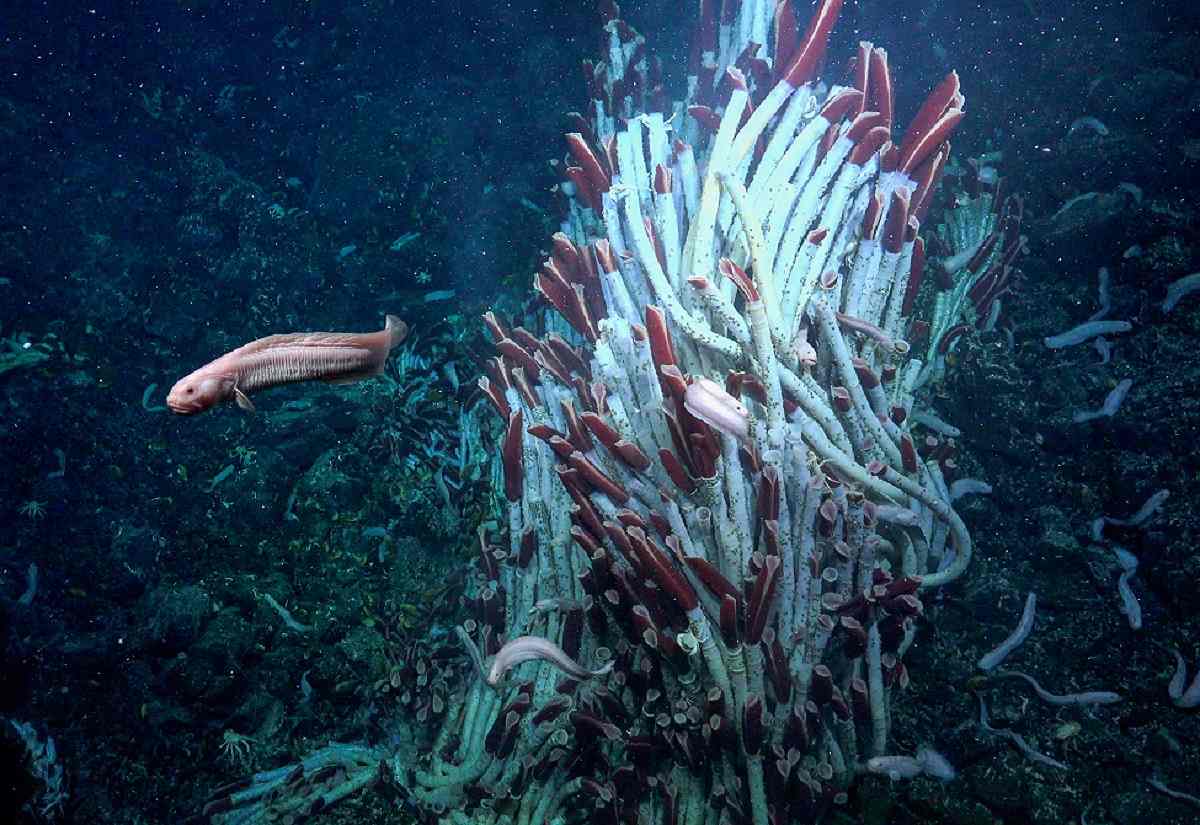
Giant tubeworms are seen on the seafloor surface at 2,500 meters water depth at the East Pacific Rise in this undated photo.
17:50 JST, November 13, 2024
WASHINGTON (Reuters) — A deep-diving robot that chiseled into the rocky Pacific seabed at a spot where two of the immense plates comprising Earth’s outer shell meet has unearthed a previously unknown realm of animal life thriving underground near hydrothermal vents.
Giant tubeworms — the world’s heftiest worms — and other marine invertebrates such as snails and bristle worms were found using the remotely operated underwater vehicle SuBastian. They were living inside cavities within the Earth’s crust at an ocean-floor site where the Pacific is 2,515 meters deep. All the species were previously known to have lived near such vents, but never underground.
“We discovered vent animal life in the cavities of the ocean’s crust. We now know that the unique hydrothermal vent ecosystem extends into the ocean’s crust,” said marine biologist Sabine Gollner of the Royal Netherlands Institute for Sea Research, one of the leaders of the study published recently in the journal Nature Communications.
“To our knowledge, it is the first time that animal life has been discovered in the ocean crust,” Gollner added.
The exploration was conducted at the East Pacific Rise, a volcanically active ridge on the floor of the southeastern Pacific, running approximately parallel to South America’s west coast. Earth’s rigid outer part is divided into colossal plates that move gradually over time in a process called plate tectonics. The East Pacific Rise is located where two such plates are gradually spreading apart.
This area contains many hydrothermal vents, fissures in the seafloor situated where seawater and magma beneath the Earth’s crust come together. Magma refers to molten rock that is underground, while lava refers to molten rock that reaches the surface, including the seafloor. New seafloor forms in places where magma is forced upward toward the surface at a mid-ocean ridge and cools to form volcanic rock.
The hydrothermal vents spew into the cold sea the super-heated and chemical-rich water that nourishes microorganisms.
“The warm venting fluids are rich in energy — for example, sulfide — that can be used by microbes, which form the basis of the food-chain,” Gollner said.
Life flourishes around the vents — including giant tubeworms reaching lengths of 3 meters, mussels, crabs, shrimp, fish and other organisms beautifully adapted to this extreme environment. The giant tubeworms do not eat as other animals do. Instead, bacteria residing in their body in a sack-like organ turn sulfur from the water into energy for the animal.
The researchers deployed SuBastian from the Schmidt Ocean Institute research vessel Falkortoo to the vent site deep below. The robot was equipped with arms that wielded a chisel that the researchers used to dig into the crust and uncover warm and fluid-filled cavities where the tubeworms, bristle worms and snails were spotted.
“We used a chisel to break the rock. We dug about 20 centimeters. The lava plates were about 10 centimeters thick. The cavities below the lava plates were about 10 centimeters in height,” Gollner said.
Larvae from these animals may invade these subseafloor habitats, the researchers said, in an example of connectivity between the seafloor and underground ecosystems.
“It changed our view on connectedness in the ocean,” Gollner said of discovering the subsurface lair.
"Science & Nature" POPULAR ARTICLE
-

Genome Study Reveals Milestone in History of Cat Domestication
-

Big Leap in Quest to Get to Bottom of Climate Ice Mystery
-

Security Camera Footage Vulnerable to Outside Access; Investigation Finds 3,000 Pieces Exposed Online
-

Japan Set to Participate in EU’s R&D Framework, Aims to Boost Cooperation in Tech, Energy
-

Paws on Parade: Nairobi’s Dogs Dazzle at ‘Pawchella’
JN ACCESS RANKING
-

Tokyo Economic Security Forum to Hold Inaugural Meeting Amid Tense Global Environment
-

Keidanren Chairman Yoshinobu Tsutsui Visits Kashiwazaki-Kariwa Nuclear Power Plant; Inspects New Emergency Safety System
-

Imports of Rare Earths from China Facing Delays, May Be Caused by Deterioration of Japan-China Relations
-

University of Tokyo Professor Discusses Japanese Economic Security in Interview Ahead of Forum
-

Japan Pulls out of Vietnam Nuclear Project, Complicating Hanoi’s Power Plans






















